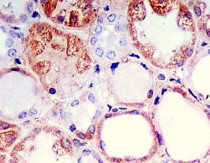ARG41139
anti-TGFBI antibody
anti-TGFBI antibody for ICC/IF,IHC-Formalin-fixed paraffin-embedded sections,Western blot and Human,Rat
Overview
| Product Description | Rabbit Polyclonal antibody recognizes TGFBI |
|---|---|
| Tested Reactivity | Hu, Rat |
| Tested Application | ICC/IF, IHC-P, WB |
| Host | Rabbit |
| Clonality | Polyclonal |
| Isotype | IgG |
| Target Name | TGFBI |
| Antigen Species | Human |
| Immunogen | Synthetic peptide derived from Human TGFBI. |
| Conjugation | Un-conjugated |
| Alternate Names | CDGG1; LCD1; RGD-CAP; CSD2; CSD; Beta ig-h3; CSD1; Transforming growth factor-beta-induced protein ig-h3; RGD-containing collagen-associated protein; BIGH3; CDG2; CSD3; Kerato-epithelin; CDB1; EBMD |
Application Instructions
| Application Suggestion |
|
||||||||
|---|---|---|---|---|---|---|---|---|---|
| Application Note | * The dilutions indicate recommended starting dilutions and the optimal dilutions or concentrations should be determined by the scientist. | ||||||||
| Positive Control | Human fetal kidney |
Properties
| Form | Liquid |
|---|---|
| Purification | Affinity purified. |
| Buffer | PBS (pH 7.4), 150 mM NaCl, 0.02% Sodium azide and 50% Glycerol. |
| Preservative | 0.02% Sodium azide |
| Stabilizer | 50% Glycerol |
| Storage Instruction | For continuous use, store undiluted antibody at 2-8°C for up to a week. For long-term storage, aliquot and store at -20°C. Storage in frost free freezers is not recommended. Avoid repeated freeze/thaw cycles. Suggest spin the vial prior to opening. The antibody solution should be gently mixed before use. |
| Note | For laboratory research only, not for drug, diagnostic or other use. |
Bioinformation
| Database Links |
Swiss-port # Q15582 Human Transforming growth factor-beta-induced protein ig-h3 |
|---|---|
| Gene Symbol | TGFBI |
| Gene Full Name | transforming growth factor, beta-induced, 68kDa |
| Background | This gene encodes an RGD-containing protein that binds to type I, II and IV collagens. The RGD motif is found in many extracellular matrix proteins modulating cell adhesion and serves as a ligand recognition sequence for several integrins. This protein plays a role in cell-collagen interactions and may be involved in endochondrial bone formation in cartilage. The protein is induced by transforming growth factor-beta and acts to inhibit cell adhesion. Mutations in this gene are associated with multiple types of corneal dystrophy. [provided by RefSeq, Jul 2008] |
| Function | Binds to type I, II, and IV collagens. This adhesion protein may play an important role in cell-collagen interactions. In cartilage, may be involved in endochondral bone formation. [UniProt] |
| Cellular Localization | Secreted. Secreted, extracellular space, extracellular matrix. Note=May be associated both with microfibrils and with the cell surface (PubMed:8077289). [UniProt] |
| Calculated MW | 75 kDa |
| PTM | Gamma-carboxylation is controversial. Gamma-carboxyglutamated; gamma-carboxyglutamate residues are formed by vitamin K dependent carboxylation; these residues may be required for binding to calcium (PubMed:18450759). According to a more recent report, does not contain vitamin K-dependent gamma-carboxyglutamate residues (PubMed:26273833). The EMI domain contains 2 expected intradomain disulfide bridges (Cys-49-Cys85 and Cys-84-Cys-97) and one unusual interdomain disulfide bridge to the second FAS1 domain (Cys-74-Cys-339). This arrangement violates the predicted disulfide bridge pattern of an EMI domain. [UniProt] |
Images (2) Click the Picture to Zoom In







